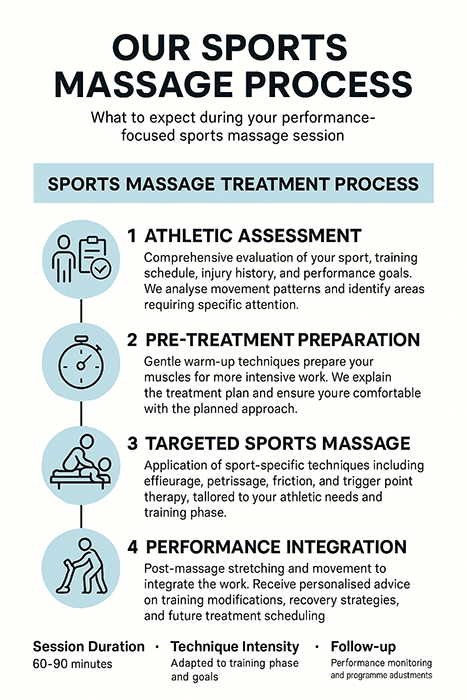Athletic Performance
Sports Massage
in London
Enhance athletic performance, accelerate recovery,
and prevent injuries with specialised sports massage therapy.
Optimise athletic potential & training
Reduce risk & maintain peak condition
Accelerated healing & reduced downtime

Specialised therapy designed for athletes and active individuals
Sports massage at Holistic Healthcare Clinics is specifically designed to support athletic performance and active lifestyles. Our qualified sports massage therapists understand the unique demands placed on athletes' bodies and use targeted techniques to enhance performance, prevent injuries, and optimise recovery.
Whether you're a professional athlete, weekend warrior, or fitness enthusiast, our sports massage treatments are tailored to your training schedule and competitive goals. We combine various massage techniques including Swedish massage, deep tissue work, and myofascial release to address your specific needs.
Our approach integrates seamlessly with your training programme, providing both pre-event preparation and post-training recovery to help you perform at your best whilst minimising injury risk.
Understanding the science behind sports massage and athletic performance
Sports massage is a specialised form of massage therapy specifically designed to support athletic performance, prevent sports injuries, and enhance recovery. It combines various massage techniques tailored to the demands of sports and physical activity.
Our sports massage therapists utilise a comprehensive range of techniques:
Sports massage works by enhancing circulation, reducing muscle tension, and optimising biomechanical function. The therapeutic benefits include:
Specialised sports massage for diverse athletic pursuits and fitness activities
Specialised treatment for runners, marathoners, and track athletes. Address overuse injuries, improve running efficiency, and maintain optimal leg muscle function for peak performance.
Support for weightlifters, bodybuilders, and gym enthusiasts. Enhance muscle recovery, prevent overtraining symptoms, and maintain flexibility alongside strength gains.
Tailored treatments for football, rugby, basketball, and other team sports. Address sport-specific movement patterns and maintain peak condition throughout the season.
Specialised care for cyclists addressing postural demands, leg muscle endurance, and repetitive motion stress from long training rides and competitions.
Treatment focused on shoulder mechanics, core stability, and stroke efficiency. Address swimmer's shoulder and maintain optimal range of motion for competitive swimming.
Support for climbers, hikers, and outdoor enthusiasts. Prepare for physical challenges and recover from demanding adventures whilst maintaining joint mobility.
Our sports massage therapists work with athletes from all disciplines and fitness levels.
Book Your Sports AssessmentPerformance advantages that give you the competitive edge
Optimise muscle function, improve biomechanics, and enhance athletic output through targeted massage techniques that prepare your body for peak performance.
Reduce recovery time between training sessions and competitions by enhancing circulation and facilitating the removal of metabolic waste products.
Identify and address muscle imbalances, tension patterns, and potential problem areas before they develop into injuries that could sideline your training.
Maintain and improve range of motion, muscle flexibility, and joint mobility essential for optimal athletic performance and movement efficiency.
Reduce pre-competition anxiety, improve focus, and enhance mind-body connection through relaxation and stress reduction benefits of sports massage.
Enhance blood flow and lymphatic drainage, delivering nutrients to muscles more efficiently whilst removing toxins that can impair performance.
What to expect during your performance-focused sports massage session

Comprehensive evaluation of your sport, training schedule, injury history, and performance goals. We analyse movement patterns and identify areas requiring specific attention.
Gentle warm-up techniques prepare your muscles for more intensive work. We explain the treatment plan and ensure you're comfortable with the planned approach.
Application of sport-specific techniques including effleurage, petrissage, friction, and trigger point therapy, tailored to your athletic needs and training phase.
Post-massage stretching and movement to integrate the work. Receive personalised advice on training modifications, recovery strategies, and future treatment scheduling.
Session Duration: 60-90 minutes
Technique Intensity: Adapted to training phase and goals
Follow-up: Performance monitoring and programme adjustments
Special introductory offer for new clients
Perfect introduction to our sports massage therapy, allowing you to experience professional athletic treatment at a special rate.
*Introductory offer limited to one session per person. All prices include initial athletic assessment and performance guidance.
Real experiences from our sports massage clients

"The sports massage has completely transformed my training routine. I recover much faster between sessions and my performance has noticeably improved since starting regular treatments."

"As a competitive cyclist, sports massage is essential for my training. The therapist understands athletic demands and tailors each session perfectly to my competition schedule."

"The sports massage therapy has been crucial for my rugby performance. I feel more prepared for matches and recover much quicker after intense training sessions."
Common questions about sports massage therapy for athletes
The timing of sports massage depends on your training goals and phase:
Your therapist will recommend the best timing based on your training schedule and competitive calendar.
Yes, sports massage differs significantly from regular relaxation massage:
Sports massage therapists have specialised training in anatomy, physiology, and sports medicine principles. They understand how different sports affect the body and can tailor treatments to enhance athletic performance rather than just provide relaxation.
Sports massage frequency varies based on your training intensity, sport demands, and goals:
Your sports massage therapist will create a personalised schedule that integrates with your training programme and adapts to your competitive calendar.
Yes, sports massage is highly effective for injury prevention through several mechanisms:
Regular sports massage creates awareness of your body's condition, helping you and your therapist identify potential issues early. Combined with proper training, nutrition, and rest, sports massage forms a comprehensive injury prevention strategy.
However, sports massage works best as part of a holistic approach including proper warm-up, cool-down, strength training, and technique refinement.
Absolutely not! Sports massage benefits anyone who is physically active, regardless of skill level or competitive status:
Who Benefits from Sports Massage:
Benefits for Non-Professional Athletes:
Our sports massage therapists adapt techniques to your fitness level and goals. Whether you're training for your first 5K or simply want to enjoy weekend activities without pain, sports massage can enhance your physical performance and wellbeing.
The key is communicating your activity level, goals, and any concerns with your therapist so they can tailor the treatment appropriately.
Have other questions about sports massage? Contact our team for personalised answers or book a consultation.
Book your sports massage today and experience the competitive advantage of professional athletic care.